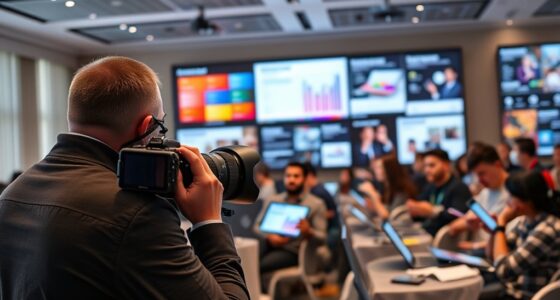To set clear event goals and objectives, define your primary purpose and what you want attendees to gain. This helps guide your planning, keep your team focused, and allocate resources wisely. Well-defined goals also provide benchmarks to measure success and improve future events. By aligning your activities with these objectives, you’ll create a cohesive experience that engages attendees. Keep learning about the key steps to effective goal setting to make your event a success.
Key Takeaways
- Define specific, measurable outcomes aligned with the event’s purpose and desired attendee experience.
- Prioritize goals to guide resource allocation and budget planning effectively.
- Ensure goals promote engagement through activities, networking, and interactive elements.
- Communicate clear objectives to team members and vendors for aligned execution.
- Use established goals as benchmarks for evaluating success and guiding future improvements.

Have you ever wondered why some events succeed while others fall flat? The difference often comes down to how well you set your goals and objectives from the start. Clear goals give your planning direction, helping you stay focused and make informed decisions along the way. When you define what you want to achieve early on, it becomes easier to allocate your resources effectively, including your budget planning. Knowing your primary objectives helps you determine where to invest your money—whether it’s marketing, venue, entertainment, or technology—ensuring you don’t overspend on less critical areas. Plus, having specific goals allows you to measure your progress, so you can adjust your strategies as needed and stay on track to meet your expectations.
Another key aspect of setting clear goals is understanding how to foster attendee engagement. When your objectives emphasize creating a memorable experience, you naturally structure your event to maximize interaction and participation. For example, if your goal is to network and build relationships, you’ll prioritize activities like breakout sessions, Q&A periods, or interactive workshops that encourage dialogue. Clear objectives help you craft a cohesive event narrative, ensuring every element aligns with your desired attendee experience. This focus not only boosts engagement but also increases the likelihood that attendees leave satisfied and motivated to participate in future events.
Moreover, setting specific, measurable goals helps you communicate your vision to your team and vendors. When everyone understands what you’re aiming for, they can work together more efficiently, avoiding misunderstandings and redundant efforts. Clear objectives also guide your marketing and outreach efforts, allowing you to craft messaging that appeals directly to your target audience. If increasing attendee engagement is a key goal, your promotional strategies can highlight interactive features, enticing more people to participate actively. Additionally, having well-defined goals makes it easier to evaluate your event’s success afterward. You can analyze whether you achieved your objectives, such as attendance numbers, engagement levels, or networking outcomes, and gather insights for future planning. Incorporating insights from home theatre projectors can also help create immersive environments that enhance attendee experiences and support your event goals.
Frequently Asked Questions
How Do I Prioritize Multiple Event Goals Effectively?
To prioritize multiple event goals effectively, start by evaluating each goal’s impact on your overall vision and considering budget constraints. Engage stakeholders early to guarantee alignment, and identify which objectives deliver the most value. Focus on high-priority goals first, and be flexible with lower-priority ones. Regularly reevaluate your priorities as the event planning progresses, keeping everyone aligned and ensuring resources are allocated efficiently.
What Tools Can Help Track Progress Toward Event Objectives?
You can use tools like dashboards and project management software to track progress toward event objectives. These tools help you monitor event metrics in real-time, ensuring goal alignment across your team. Platforms like Google Data Studio, Trello, or Asana visualize data and deadlines, making it easier to identify areas needing attention. Regularly reviewing these tools keeps your event on track and aligned with your overall goals, ensuring a successful outcome.
How Flexible Should Event Goals Be Once Set?
You should keep your event goals flexible enough to adapt as needed, especially considering budget considerations and attendee engagement. If you’re too rigid, unexpected challenges might derail your plans. Stay open to adjustments that improve the attendee experience without overspending. Flexibility allows you to respond to real-time feedback and changing circumstances, ensuring your event remains successful and engaging while staying within your financial limits.
How Do I Communicate Goals to Team Members?
You should clearly communicate goals to your team to boost motivation and guarantee goal alignment. Use straightforward language, emphasize the purpose behind each goal, and explain how their roles contribute to success. Keep everyone informed through meetings, emails, or shared documents. Encourage questions and feedback to foster understanding and buy-in. When your team knows the goals, they stay motivated, aligned, and focused on achieving the event’s success.
What Are Common Pitfalls in Setting Event Objectives?
Think of setting event objectives like tuning an orchestra—if goals aren’t aligned, the harmony suffers. Common pitfalls include neglecting event goal alignment, leading to scattered efforts, and overlooking stakeholder engagement, which causes disconnect. You might also set vague or unrealistic objectives, making it harder to measure success. To avoid these, clarify your goals early, ensure everyone’s on the same page, and actively involve stakeholders in the planning process.
Conclusion
By setting clear goals and objectives, you create a roadmap that guides your event to success. Think of it like planting a seed—you need a strong foundation to nurture growth. When you define what you want to achieve, you can measure progress and stay focused. This approach isn’t just theory; it’s proven to boost event effectiveness. So, take the time to set your goals—your event will thank you with a memorable, impactful experience.









